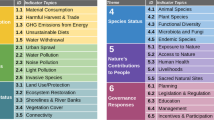Abstract
This paper advances a composite indicator called urban environmental virtuosity index (UEVI), in order to measure the efforts made by public local bodies in applying an ecosystem approach to urban management. UEVI employs the less exploited process-based selection criteria for representing the original concept of virtuosity, providing makes a cross cities comparison. In developing such a framework the main technical issue of constructing a composite indicator, involving the weighting and the aggregation phases will be overcame by using a multivariate approach.




Similar content being viewed by others
Notes
Total urban sustainability score is based on three components of the urban sustainability in China: the urban development capacity, urban coordination capacity and urban development potential.
To be clearer, this is different from the “Environmental Policy Performance Indicator” (by Adriaanse A., 1993), “that indicates whether the environmental policy is heading in the right direction or not”. It considers “two independent approaches for the scaling of the theme indicators: division by the corresponding (a) sustainability levels and (b) policy targets for each theme indicator. This results in a common unit (i.e. environmental pressure equivalents—EPeq) for expressing environmental pressure within themes. The composite indicator for each year is calculated as the sum of the six dimensionless theme equivalent” (Saisana and Tarantola 2002, p. 51).
The considered municipalities represent the main urban context in each region.
The imagine has been adapted from Ercolano and Gaeta (2012).
Database ISTAT 2008.
The aim is to verify if UEVI can be affected by a younger population.
These results could be influenced by a political control of the scarcity of water resources, while the latter could be given from the average medium size of municipalities.
References
Adriaanse, A. (1993). Environmental policy performance indicators: A study on the development of indicators for environmental policy in the Netherlands. The Hague: SDV Publishers.
Atkinson, G. D., Dubourg, R., Hamilton, K., Munasignhe, M., Pearce, D. W., & Young, C. (1997). Measuring sustainable development: Macroeconomics and the environment. Cheltenham: Edward Elgar.
Bohringer, C. (2007). Measuring the immeasurable: A survey of sustainability indices. Ecological Economics, 63, 1–8.
Coco, G., & Russo, M. (2006). Using CATPCA to evaluate market regulation. In S. Zani, et al. (Eds.), Data analysis classification and the forward search (pp. 369–376). Berlin: Springer.
Ercolano, S., & Gaeta, G. L. (2012). (Re)assessing the power of purse. A new methodology for the analysis of the institutional capacity for legislative control over the budget. Journal of Dyses (forthcoming).
European Commission. (1994). Charter of European cities and towns towards sustainability. In European conference on sustainable cities and towns, Aalborg, Denmark on May 27, 1994.
Helsinki City Urban Facts Office (2002). The core indicators for sustainable development in Helsinki. Agenda 21. Helsinki, Web publication, 2002:4
Isla, M. (1996). A review of the urban indicators experience and a proposal to overcome current situation. The application to the municipalities of the Barcelona Province. Departament d’Economía Aplicada Autonomous, University of Barcelona.
Istat. (2009). Indicatori ambientali urbani. Roma: Servizio statistiche ambientali.
Legambiente. (1994). Ecosistema urbano: Rapporto sulla qualità ambientale dei comuni capoluogo di provincia. http://www.legambiente.eu/documenti/1989-1996/ecosistemaUrbano1994.pdf.
Linting, M., Neurman, J. J., Groenen, P. J., & Van Der Koojj, A. J. (2007). Nonlinear principal components analysis: Introduction and application. Physical Methods, 12(3), 336–358.
Nardo, M., Saisana, M., Salltelli, A., & Tarantola, S. (2005). Tools for composite indicators building. Joint Research Centre and Institute for the Protection and Security of the Citizen Econometrics and Statistical Support to Antifraud Unit I-21020 Ispra, VA, Italy.
Nicoletti, G., Scarpetta, S., & Boylaud, O. (2000). Summary indicators of product market regulation with an extension to employment protection legislation. OECD Economics Department working papers no. 226.
Niemeijer, D. (2002). Developing indicators for environmental policy: Data-driven and theory-driven approaches examined by example. Environmental Science & Policy, 5, 91–103.
Niemeijer, D., & de Groot, R. S. (2008). A conceptual framework for selecting environmental indicator sets. Ecological Indicators, 8, 14–25.
OECD. (1993). Core set of indicators for environmental performance reviews. A synthesis report by the Group on the State of the Environment, Environmental monographs no. 83.
OECD, European Commission, Joint Research Centre (2008). Handbook on constructing composite indicators: Methodology and user guide, by Nardo, M. M. Saisana, A. Saltelli, and S. Tarantola (EC/JRC), A. Hoffman and E. Giovannini (OECD), Paris, OECD publication Code: 302008251E1.
Puolamaa, M., Kaplas, M. & Reinikainen T. (1996). Index of environmental friendliness: A methodological study. Helsinki: Statistics Finland/Eurostat.
Rapporto di Ambiente Italia. (2003). Verso un quadro della sostenibilità a livello locale—Indicatori comuni europei (ICE), Roma.
Saisana, M., & Tarantola, S. (2002). State-of-the-art report on current methodologies and practices for composite indicator development. EUR report 20408 EN, European Commission, JRC-IPSC, Italy.
Saltelli, A. (2007). Composite indicators between analysis and advocacy. Social Indicators Research, 81, 65–77.
Singh, R. K., Murty, H. R., Gupta, S. K., & Dikshit, A. K. (2009). An overview of sustainability assessment methodologies. Ecological Indicators, 5(3), 189–212.
Svedin, L. M. (2009). Organizational cooperation in crises. Farnham: Ashgate.
UN Habitat. (2002). Global urban indicators database, version 2. Nairobi, Kenya: Global Urban Observatory, United Nations Human Settlements Programme.
Zhang, M. (2002). Measuring urban sustainability in China. Thela thesis, Amsterdam.
Acknowledgments
This work is a result of continuous and shared ideas between the two authors; however Salvatore Ercolano wrote paragraphs 3,4,5, while Oriana Romano wrote paragraphs 1,2,6. We would like to thank Professors Pietro Rostirolla, Amedeo Di Maio, John Sedgwick, Abay Mulatu and Dr. Rintaro Yamaguchi for the useful comments.
Author information
Authors and Affiliations
Corresponding author
Rights and permissions
About this article
Cite this article
Romano, O., Ercolano, S. Who Makes the Most? Measuring the “Urban Environmental Virtuosity”. Soc Indic Res 112, 709–724 (2013). https://doi.org/10.1007/s11205-012-0078-9
Accepted:
Published:
Issue Date:
DOI: https://doi.org/10.1007/s11205-012-0078-9




